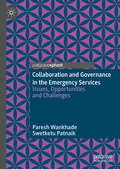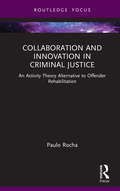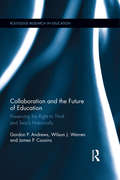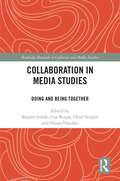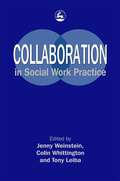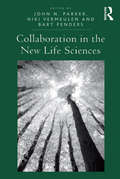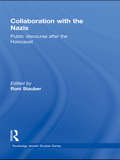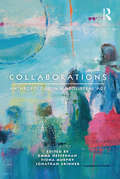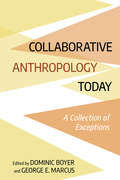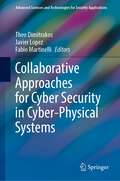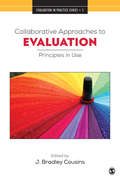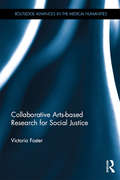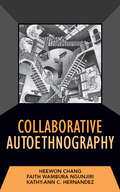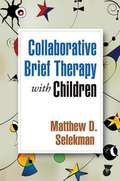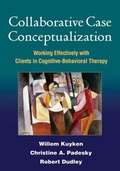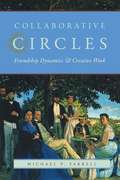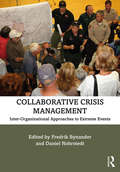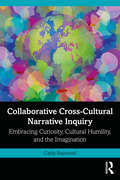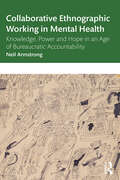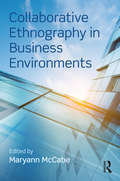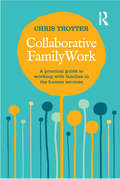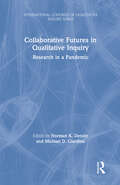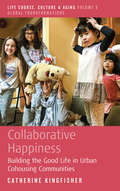- Table View
- List View
Collaboration and Governance in the Emergency Services: Issues, Opportunities and Challenges
by Paresh Wankhade Swetketu Patnaik“Globally, emergency services are witnessing a period of unprecedented uncertainty and change caused by pressure on their budgets, reduced manpower and changing patterns of demand and service delivery. Such challenges are also having huge implications on the workforce health and wellbeing. This book is a timely, well-researched addition to improve our understanding of the governance and collaboration issues in the emergency services.”Steve McGuirk, Chairman, Warrington and Halton Hospitals Trust, Former Chief Fire Officer and CEO, Greater Manchester Fire and Rescue Service“Good governance, collaboration and sound leadership are easy qualities to take for granted in the Emergency Services. However, given the increasing complexity of the challenging political and operational environments these organisations work in, it is not reasonable to assume these qualities will always emerge as a natural phenomenon. This book is a welcome addition that provides invaluable, evidence-based insights for leaders who are seeking to raise the quality of their services for both the public and their workforce alike.”Andy Newton, Immediate Past Chair, College of Paramedics and Former Paramedic Director, South East Coast Ambulance Service NHS Trust (SECAmb)This unique text provides fresh insights and understanding of the governance and collaboration issues between emergency services in a dynamic policy and organisational environment in a global world. The book offers critical insights into the theory and rationale behind the interoperability and collaboration between the emergency services and examines in detail, important themes around trust, leadership, workforce wellbeing and resilience and professional culture(s), each having great significance for the success of the interoperability and governance agenda. The chapters cover new materials, including the research conducted by the authors and are written in a style that is easily accessible. This book caters to a wide audience of researchers, academics, students, emergency services staff, leaders and public managers, both in the UK and internationally.
Collaboration and Innovation in Criminal Justice: An Activity Theory Alternative to Offender Rehabilitation (Routledge Frontiers of Criminal Justice)
by Paulo RochaDrawing on original research on community-based alternatives to offender rehabilitation, this book provides an up to date depiction of the challenges faced by front-line workers at the interface between criminal justice and welfare systems striving to address needs and provide multifaceted solutions. Using an innovative theoretical predicated on Activity Theory (AT) to dissect the problem, the book makes the case for co-created rehabilitation strategies that address the needs of offenders – which can only be achieved with the involvement of health and social welfare services as a means to provide a holistic support to individuals – and regard for the dilemmas front-line professionals face to deploy such strategies – which means shifting the top-down paradigm of policy implementation for co-created solutions. The book explores how AT can be used to help design commensurate interventions that give voice to all the interested actors involved in the rehabilitation process and providing readers with tools that help translate theory into practice. This book is essential reading for students, researcher, practitioners and other stakeholders focusing on co-created, bottom-up alternatives to imprisonment that benefit both offenders, community and the state.
Collaboration and the Future of Education: Preserving the Right to Think and Teach Historically (Routledge Research in Education)
by Gordon Andrews Wilson J. Warren James CousinsCurrent educational reforms have given rise to various types of "educational Taylorism," which encourage the creation of efficiency models in pursuit of a unified way to teach. In history education curricula, this has been introduced through scripted textbook-based programs such as Teacher Curriculum Institute’s History Alive! and completely online curricula. They include the jargon of authentic methods, such as primary sources, cooperative learning, differentiated instruction, and access to technology; yet the craft of teaching is removed, and an experience that should be marked by discovery and reflection is replaced with comparatively empty processes. This volume provides systematic models and examples of ways that history teachers can compete with and effectively halt this transformation. The alternatives the authors present are based on collaborative models that address the art of teaching for pre-service and practicing secondary history teachers as well as collegiate history educators. Relying on original research, and a maturing body of secondary literature on historical thinking, this book illuminates how collaboration can create real historical learning.
Collaboration in Media Studies: Doing and Being Together (Routledge Research in Cultural and Media Studies)
by Onur Sesigür Begüm Irmak Can Koçak Nazan HaydariThis volume offers new perspectives on knowledge production through various forms of togetherness. Via diverse cases of collaboration in media studies, from methodological contemplations to on‑the‑field social practices, the book proposes reflections and inquiries around collective research, media, and action.The collection rethinks how scholarly endeavours feature different ways of doing and being together, identifying new and more diverse communicative spaces, challenging dichotomies, and encouraging critical perspectives. Scholars of a variety of disciplines recontextualise collaboration beyond the very nature of conventional academic approaches, to embrace vast connotations of media studies – from actions building connections across research and practice to transdisciplinary methodologies through analogue and digital realms.This book will be an invaluable resource for scholars and post‑graduate students from various fields of media studies, who carry an interest in collaborative and collective aspects of media as practice and research, as well as those in a variety of social science disciplines, participatory action research, media sociology, audience studies, intercultural communication, qualitative research methods, and participatory communication.
Collaboration in Social Work Practice
by Jenny Weinstein Ruth Gardner Tony LeibaNew or experienced social workers who are developing their collaborative practice with service users and carers and with other professionals, will find this book to be an essential source of knowledge, skills and issues for reflection. The authors explain how practitioners in social care, health and related sectors can work more effectively together in line with current developments in policy and practice, offering a critical appraisal both of the benefits and the challenges. The authors explore definitions of collaborative work, describe policy and research and give examples from their experiences of interprofessional practice. They emphasize the importance of building genuine partnerships between professionals, and with service users and carers in planning and providing care, service development and research. Good practice in collaborative working is described with different groups, including older people, people with mental health needs, children and families and people with learning disabilities. Exploring the ways in which shared values and collaborative working practices can be brought together for effective interprofessional provision of user-focused services, this informative book is a must-read for social workers and other professionals involved with social care and health services.
Collaboration in Social Work Practice
by Jenny Weinstein Ruth Gardner Tony LeibaNew or experienced social workers who are developing their collaborative practice with service users and carers and with other professionals, will find this book to be an essential source of knowledge, skills and issues for reflection. The authors explain how practitioners in social care, health and related sectors can work more effectively together in line with current developments in policy and practice, offering a critical appraisal both of the benefits and the challenges.The authors explore definitions of collaborative work, describe policy and research and give examples from their experiences of interprofessional practice. They emphasize the importance of building genuine partnerships between professionals, and with service users and carers in planning and providing care, service development and research. Good practice in collaborative working is described with different groups, including older people, people with mental health needs, children and families and people with learning disabilities.Exploring the ways in which shared values and collaborative working practices can be brought together for effective interprofessional provision of user-focused services, this informative book is a must-read for social workers and other professionals involved with social care and health services.
Collaboration in the New Life Sciences
by Bart Penders Niki Vermeulen John N. ParkerIn recent years the organisation and practice of collaboration in the life sciences has undergone radical transformations, owing to the advent of big science enterprises, newly developed data gathering and storage technologies, increasing levels of interdisciplinarity, and changing societal expectations for science. Collaboration in the New Life Sciences examines the causes and consequences of changing patterns of scientific collaboration in the life sciences. This book presents an understanding of how and why collaboration in the life sciences is changing and the effects of these changes on scientific knowledge, the work lives and experiences of scientists, social policy and society. Through a series of thematically arranged chapters, it considers the social, technical, and organizational facets of collaboration, addressing not only the rise of new forms of collaboration in the life sciences, but also examining recent developments in two broad research areas: ecology and environment, and the molecular life sciences. With an international team of experts presenting case studies and analyses drawn from the US, UK, Asia and Europe, Collaboration in the New Life Sciences will appeal not only to scholars and students of science and technology studies, but also to those interested in science and social policy, and the sociology of work and organisations.
Collaboration with the Nazis: Public Discourse after the Holocaust (Routledge Jewish Studies Series)
by Roni StauberThis book examines the changes in representing collaboration, during the Holocaust, especially in the destruction of European Jewry, in the public discourse and the historiography of various countries in Europe that were occupied by the Germans, or were considered, at least during part of the war, as Germany's allies or satellites. In particular, it shows how representations and responses have been conditioned by national and political trends and constraints. As historical background to the issues of postwar collective memory and public discourse, it includes references to and short descriptions of major manifestations of collaboration, chiefly in regards to the Jews, in each of these countries during the war. Whether they were Communist or democratic regimes, the book shows how the sudden burden of the past was suppressed, denied or distorted in various periods. Covering a wide area of both Eastern and Western Europe from different specialist perspectives, this comprehensive study of collaboration in the Holocaust and its aftermath will be a valuable tool for teachers and students in the field of modern European history and Holocaust studies.
Collaborations: Anthropology in a Neoliberal Age (Criminal Practice Ser.)
by Jonathan Skinner Fiona Murphy Emma HeffernanCollaborations responds to the growing pressure on the humanities and social sciences to justify their impact and utility after cuts in public spending, and the introduction of neoliberal values into academia. Arguing ‘in defense of’ anthropology, the editors demonstrate the continued importance of the discipline and reveal how it contributes towards solving major problems in contemporary society. They also illustrate how anthropology can not only survive but thrive under these conditions. Moreover, Collaborations shows that collaboration with other disciplines is the key to anthropology’s long-term sustainability and survival, and explores the challenges that interdisciplinary work presents. The book is divided into two parts: Anthropology and Academia, and Anthropology in Practice. The first part features examples from anthropologists working in academic settings which range from the life, behavioural and social sciences to the humanities, arts and business. The second part highlights detailed ethnographic contributions on topics such as peace negotiations, asylum seekers, prostitution and autism. Collaborations is an important read for students, scholars and professional and applied anthropologists as it explores how anthropology can remain relevant in the contemporary world and how to prevent it from becoming an increasingly isolated and marginalized discipline.
Collaborative Anthropology Today: A Collection of Exceptions
As multisited research has become mainstream in anthropology, collaboration has gained new relevance and traction as a critical infrastructure of both fieldwork and theory, enabling more ambitious research designs, forms of communication, and analysis. Collaborative Anthropology Today is the outcome of a 2017 workshop held at the Center for Ethnography, University of California, Irvine. This book is the latest in a trilogy that includes Fieldwork Is Not What It Used to Be and Theory Can Be More Than It Used to Be. Dominic Boyer and George E. Marcus assemble several notable ventures in collaborative anthropology and put them in dialogue with one another as a way of exploring the recent surge of interest in creating new kinds of ethnographic and theoretical partnerships, especially in the domains of art, media, and information. Contributors highlight projects in which collaboration has generated new possibilities of expression and conceptualizations of anthropological research, as well as prototypes that may be of use to others contemplating their own experimental collaborative ventures.
Collaborative Approaches for Cyber Security in Cyber-Physical Systems (Advanced Sciences and Technologies for Security Applications)
by Javier Lopez Fabio Martinelli Theo DimitrakosThis book describes cyber-security issues underpinning several cyber-physical systems and several application domains, proposing a common perspective able to collect similarities as well as depict divergences and specific solution methods. Special attention is given to those approaches and technologies that unleash the power of collaboration among stakeholders, in a field based often developed in isolation and segregation of information. Given the pervasively growing dependency of society on IT technology, and the corresponding proliferation of cyber-threats, there is both an imperative need and opportunity to develop a coherent set of techniques to cope with the changing nature of the upcoming cyber-security challenges. These include evolving threats and new technological means to exploit vulnerabilities of cyber-physical systems that have direct socio-technical, societal and economic consequences for Europe and the world. We witness cyber-attacks on large scale infrastructures for energy, transport, healthcare systems and smart systems. The interplay between security and safety issues is now paramount and will be even more relevant in the future. The book collects contributions from a number of scientists in Europe and presents the results of several European Projects, as NeCS, SPARTA, E-CORRIDOR and C3ISP. It will be of value to industrial researchers, practitioners and engineers developing cyber-physical solutions, as well as academics and students in cyber-security, ICT, and smart technologies in general.
Collaborative Approaches to Evaluation: Principles in Use (Evaluation in Practice Series #3)
by J. Bradley CousinsEditor J. Bradley Cousins and colleagues meet the needs of evaluators seeking to implement collaborative and participatory approaches to evaluation in Collaborative Approaches to Evaluation: Principles in Use. Using a multi-phase empirical process to develop and validate a set of principles to guide collaborative approaches to evaluation, the book outlines the principles that the team developed, and then provides case studies of how these principles have been applied in practice. The case studies draw on programs globally in education, health, and community development. The book is an invaluable supplementary text for program evaluation courses where students’ projects are focused on more collaborative and participatory approaches, and it is an essential resource for practicing evaluators and those who commission program evaluations.
Collaborative Approaches to Evaluation: Principles in Use (Evaluation in Practice Series #3)
by J. Bradley CousinsEditor J. Bradley Cousins and colleagues meet the needs of evaluators seeking to implement collaborative and participatory approaches to evaluation in Collaborative Approaches to Evaluation: Principles in Use. Using a multi-phase empirical process to develop and validate a set of principles to guide collaborative approaches to evaluation, the book outlines the principles that the team developed, and then provides case studies of how these principles have been applied in practice. The case studies draw on programs globally in education, health, and community development. The book is an invaluable supplementary text for program evaluation courses where students’ projects are focused on more collaborative and participatory approaches, and it is an essential resource for practicing evaluators and those who commission program evaluations.
Collaborative Arts-based Research for Social Justice (Routledge Advances in the Medical Humanities)
by Victoria FosterThis book provides a thought-provoking guide to conducting collaborative arts-based research. Focusing on ways that social inquiry might be conducted with marginalised groups to promote social justice, the text offers chapters on: Telling ‘alternative’ stories through a variety of methods from crafts to digital film Visual and metaphorical approaches to social research including photography, art and poetry Performative methods that include drama, dance, music and performance art Foster introduces relevant methodological debates, giving a context for understanding when arts-based research can be a fruitful approach to take and outlining a convincing rationale for using the arts as a way of understanding and representing the social world. The book also suggests a range of alternative criteria for evaluating the quality of arts-based research. Illustrative examples from around the world are used throughout the book and an extended case study is included that focuses on Foster’s own collaborative arts-based research. With their emphasis on the value of participative research and social justice, arts-based methodologies are becoming increasingly popular in health and social research. This is the ideal text for anyone looking to introduce arts-based methods into their research practice.
Collaborative Autoethnography (Developing Qualitative Inquiry #8)
by Heewon Chang Faith Ngunjiri Kathy-Ann C HernandezIt sounds like a paradox: How do you engage in autoethnography collaboratively? Heewon Chang, Faith Ngunjiri, and Kathy-Ann Hernandez break new ground on this blossoming new array of research models, collectively labeled Collaborative Autoethnography. Their book serves as a practical guide by providing you with a variety of data collection, analytic, and writing techniques to conduct collaborative projects. It also answers your questions about the bigger picture: What advantages does a collaborative approach offer to autoethnography? What are some of the methodological, ethical, and interpersonal challenges you’ll encounter along the way? Model collaborative autoethnographies and writing prompts are included in the appendixes. This exceptional, in-depth resource will help you explore this exciting new frontier in qualitative methods.
Collaborative Brief Therapy with Children
by Eliana Gil Matthew SelekmanIn this engaging guide, Matthew Selekman presents cutting-edge strategies for helping children and their families overcome a wide range of emotional and behavioral challenges. Vivid case material illustrates how to engage clients rapidly and implement interventions that elicit their strengths. Integrating concepts and tools from a variety of therapeutic traditions, Selekman describes creative applications of interviewing, family art and play, postmodern and narrative techniques, and positive psychology. He highlights ways to promote spontaneity, fun, and new possibilities especially with clients who feel stuck in longstanding difficulties and entrenched patterns of interaction. The book updates and refines the approach originally presented in Selekman's acclaimed Solution-Focused Therapy with Children.
Collaborative Case Conceptualization
by Christine Padesky Willem KuykenPresenting an innovative framework for tailoring cognitive-behavioral interventions to each client's needs, this accessible book is packed with practical pointers and sample dialogues. Step by step, the authors show how to collaborate with clients to develop and test conceptualizations that illuminate personal strengths as well as problems, and that deepen in explanatory power as treatment progresses. An extended case illustration demonstrates the three-stage conceptualization process over the entire course of therapy with a multiproblem client. The approach emphasizes building resilience and coping while decreasing psychological distress. Special features include self-assessment checklists and learning exercises to help therapists build their conceptualization skills.
Collaborative Circles: Friendship Dynamics and Creative Work
by Michael P. FarrellMany artists, writers, and other creative people do their best work when collaborating within a circle of like-minded friends. Experimenting together and challenging one another, they develop the courage to rebel against the established traditions in their field. Out of their discussions they develop a new, shared vision that guides their work even when they work alone. In a unique study that will become a rich source of ideas for professionals and anyone interested in fostering creative work in the arts and sciences, Michael P. Farrell looks at the group dynamics in six collaborative circles: the French Impressionists; Sigmund Freud and his friends; C. S. Lewis, J. R. R. Tolkien, and the Inklings; social reformers Elizabeth Cady Stanton and Susan B. Anthony; the Fugitive poets; and the writers Joseph Conrad and Ford Maddox Ford. He demonstrates how the unusual interactions in these collaborative circles drew out the creativity in each member. Farrell also presents vivid narrative accounts of the roles played by the members of each circle. He considers how working in such circles sustains the motivation of each member to do creative work; how collaborative circles shape the individual styles of the persons within them; how leadership roles and interpersonal relationships change as circles develop; and why some circles flourish while others flounder.
Collaborative Crisis Management: Interorganizational Approaches to Extreme Events
by Fredrik Bynander Daniel NohrstedtPublic organizations are increasingly expected to cope with crisis under the same resource constraints and mandates that make up their normal routines, reinforced only through collaboration. Collaborative Crisis Management introduces readers to how collaboration shapes societies’ capacity to plan for, respond to, and recover from extreme and unscheduled events. Placing emphasis on five conceptual dimensions, this book teaches students how this panacea works out on the ground and in the boardrooms, and how insights on collaborative practices can shed light on the outcomes of complex inter-organizational challenges across cases derived from different problem areas, administrative cultures, and national systems. Written in a concise, accessible style by experienced teachers and scholars, it places modes of collaboration under an analytical microscope by assessing not only the collaborative tools available to actors but also how they are used, to what effect, and with which adaptive capacity. Ten empirical chapters span different international cases and contexts discussing: Natural and "man-made" hazards: earthquakes, hurricanes, wildfires, terrorism, migration flows, and violent protests Different examples of collaborative institutions, such as regional economic communities in Africa, and multi-level arrangements in Canada, the Netherlands, Turkey, and Switzerland Application of a multimethod approach, including single case studies, comparative case studies, process-tracing, and "large-n" designs. Collaborative Crisis Management is essential reading for those involved in researching and teaching crisis management.
Collaborative Cross-Cultural Narrative Inquiry: Embracing Curiosity, Cultural Humility, and the Imagination
by Cathy RaymondCollaborative Cross-Cultural Narrative Inquiry invites readers to participate in the experience of engaging in and reflecting on the author’s collaborative cross-cultural narrative research online with Parvana, an Afghan woman living in Afghanistan until August 2021.Storied reflections along with excerpts from interviews, storied data, doctoral assignments, peer feedback, analytic memos, and more illustrate how ethical practice, vulnerability, and care informed the collaborative exploration of Parvana’s life story and her daily multiple literacy practices for navigating Afghan society as an Afghan woman. Each chapter of this book offers reflections on individual elements of our cross-cultural narrative research to give readers an evocative account of our collaborative journey; at the end of each chapter, reflective prompts invite readers to engage in focused practice and explorations as they develop their own meaningful and mindful narrative studies. With its emphasis on research and relationship ethics, self-reflective practice, cultural humility, and creative approaches to analysis and representation, the cross-cultural narrative study at the heart of this textbook also offers readers insights into developing mindful and meaningful cross-cultural narrative research rooted in curiosity, humility, and the imagination.This textbook is suitable for qualitative researchers, professors, students, and others from a wide variety of fields who are interested in teaching, researching, or learning more about designing and engaging in narrative research.
Collaborative Ethnographic Working in Mental Health: Knowledge, Power and Hope in an Age of Bureaucratic Accountability
by Neil ArmstrongCollaborative Ethnographic Working in Mental Health seeks to chart a new direction for research into mental healthcare, with the aim of creating the conditions for more productive interdisciplinary dialogue. People involved in mental health often fail to recognise how they are described by researchers from the humanities and social sciences, which inhibits productive collaboration. This book seeks to address this problem, by including clinicians and patients in the research process and by shifting attention away from power and knowledge and towards the organisational context. It explores how clinical thinking and behaviour, illness experience, and clinical relationships are all shaped by the bureaucratic context. In particular, it examines tensions between what we want from mental healthcare and how accountable bureaucracies actually work, and proposes that mental healthcare research should not just evaluate new interventions but should investigate new ways of organising. This book is written with a non-specialist audience in mind, as it is intended for all with a stake in mental healthcare research and practice. It is also for those with an interest in ethnographic methods, as a novel way of deploying ethnography, autoethnography and coproduced ethnography to address clinically important research topics.
Collaborative Ethnography in Business Environments
by Maryann McCabeIn a global and rapidly changing commercial environment, businesses increasingly use collaborative ethnographic research to understand what motivates their employees and what their customers value. In this volume, anthropologists, marketing professionals, computer scientists and others examine issues, challenges, and successes of ethnographic cooperation in the corporate world. The book argues that constant shifts in the global marketplace require increasing multidisciplinary and multicultural teamwork in consumer research and organizational culture; addresses the need of corporate ethnographers to be adept at reading and translating the social constructions of knowledge and power, in order to contribute to the team process of engaging research participants, clients and stakeholders; reveals the essentially dynamic process of collaborative ethnography; shows how multifunctional teams design and carry out research, communicate findings and implications for organizational objectives, and craft strategies to achieve those objectives to increase the vibrancy of economies, markets and employment rates worldwide.
Collaborative Family Work: A practical guide to working with families in the human services
by Chris TrotterLife can be a struggle for some families and support from skilled human service workers can make a real difference.Collaborative Family Work offers practical strategies for working with families, always emphasising the importance of collaboration in assisting them in developing strategies to learn new skills and improve their lives. Chris Trotter explains how to identify strengths, assist families in setting goals, articulate strategies for change and develop methods of ongoing evaluation.He offers a systematic overview of family work models and theories, from long-term therapeutic and narrative approaches to short-term solution-focused and mediation models. His evidence-based model for family work draws on extensive field research and observation with experienced professionals.Collaborative Family Work is a valuable reference for professionals seeking to enhance their professional skills, and an essential text for students in the human services.'Chris Trotter addresses the ''how'' of practice in a field that is often stronger on general principles than it is on practical detail.' - Dr Chris Beckett, University of East Anglia, UK
Collaborative Futures in Qualitative Inquiry: Research in a Pandemic (International Congress of Qualitative Inquiry Series)
by Norman K. Denzin Michael D. GiardinaCollaborative Futures in Qualitative Inquiry critically reflects on and explores the role of qualitative research amidst the global COVID-19 pandemic. Against this unprecedented backdrop, it asks what research means during a global pandemic and what it means to be an academic. Leading international scholars from the United States, Canada, Chile, New Zealand, Norway, and the United Kingdom wrestle with the changing dynamics of research in pandemic times. Collectively and collaboratively, contributors call for a critical, performative, social justice inquiry directed at the multiple crises of our historical present—a rethinking of where we have been, and, critically, where we are going. More specifically, contributors focus on such topics as: the emotional geographies of academic writing; assaults on science and truth; pedagogies of the imagination; indigenization and reconciliation; the search for our common humanity; and the relevance of qualitative inquiry in an era of big data and digital transformation. Collaborative Futures in Qualitative Inquiry is a must-read for faculty and students alike who are interested in imagining new ways to collaborate, to engage in research and activism, and represent and intervene into social life in pandemic times.
Collaborative Happiness: Building the Good Life in Urban Cohousing Communities (Life Course, Culture and Aging: Global Transformations #8)
by Catherine KingfisherUnderstudied relative to other forms of intentional community, and under-recognized in policy-making circles, urban cohousing communities situate wellbeing as simultaneously social and subjective, while catering for groups of people so diverse in age. Collaborative Happiness looks at two such urban cohousing communities: Kankanmori, in Tokyo; and Quayside Village, in Vancouver. In expanding beyond mainstream approaches to happiness focused exclusively on the individual, Quayside Village and Kankanmori provide an alternative model for how to understand and practice the good life in an increasingly urbanized world marked by crisis of both social and environmental sustainability.
